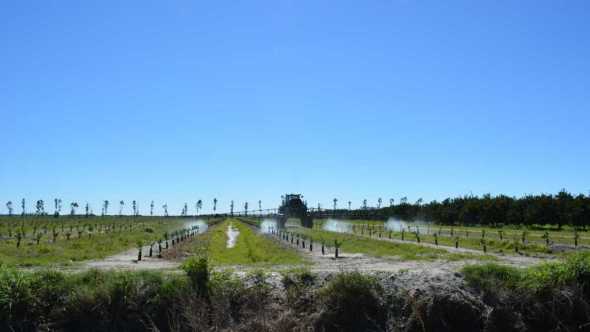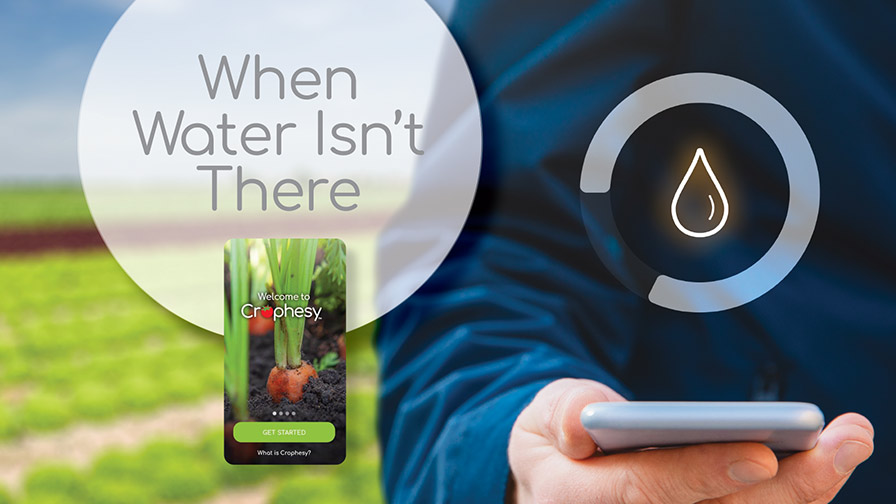Florida Citrus Growers Banking On Bactericides
One category of therapy to HLB that has likely been the highest in demand in recent years is the use of bactericides to try to knock back the disease’s bacteria in infected trees. During the 2014 Florida Citrus Industry Annual Conference, Premier Citrus’ Tom Jerkins even urged the crowd into a cheer — “We want bactericides now!”

Photo by Frank Giles
It appears those calls are being heard and hopefully growers will have these tools in hand by the early spring. Currently, three products are in the process of evaluation in an attempt to obtain a Section 18 emergency exemption. Two products from AgroSource are FireWall 50 (streptomycin) and FireLine 17 (oxytetracycline). The third is NuFarm’s Mycoshield (oxytetracycline).
Given tumbling crop estimates, there is no question this is an emergency citrus growers must reckon with. According to Mike Aerts, Director of Production and Supply Chain Management for FFVA, everyone involved in the process understands the importance of getting the Section 18 approved as fast as possible.
“It is called an emergency exemption, but it is not an immediate process,” he says. “There are three types of Section 18s — specific, quarantine, and crisis. We are petitioning for a specific exemption for the three bactericides in question in this instance.”
FFVA is the petitioner, but the petitioning agent is the Florida Department of Agriculture and Consumer Services (FDACS). The petitions were sent to the state agency in October, and they are currently under review before being sent to EPA for analysis.
Aerts added these three petitions are different than most. In most cases, when a petition is made to get approval for a particular compound, data is provided to prove things like the product will increase grower revenues by a certain percentage.
“For these Section 18s, the goal is improving tree health,” Aerts says. “That is really more of a subjective area and not as easily documented. So what FFVA submitted to FDACS for review is four times the size of a typical petition. I think it totaled something like 54 pounds of paper.”
According to Taw Richardson, President and CEO of AgroSource, everyone is working hard to supply EPA the data it needs to grant an approval.
“AgroSource’s work has been done under a cooperative research and development agreement (CRADA) with USDA-ARS in Ft. Pierce,” he says. “The principal investigators are Dr. Bob Shatters, a molecular biologist with USDA-ARS, and Dr. Ed Stover, a geneticist with the same agency, and Mark Trimmer from AgroSource. The Citrus Research and Development Foundation has provided grants to AgroSource for the CRADA over the past 16 months to expedite the studies.
“At AgroSource, we have 17 people who are working full or part time on this project and there are six people from USDA-ARS working on this,” Richardson says. “We have a very concerted effort to make progress on delivering a bactericide therapy for HLB management.”
Efficacy And Residues
One of the key pieces of evidence EPA will need for approval is whether or not these materials improve health and reduce the bacteria in trees. Richardson says his team has been very pleased with trial results thus far. From lab work to greenhouse, and ultimately field trials over the past two years, the FireLine and FireWall therapies are performing.
“The field work has shown the most promise because we have trials in every citrus growing area,” he says. “The results have been surprisingly clear in this short of a period that the treatments are having a statistically significant impact on reducing the bacterial titer in the tree, coupled with measurements of fruit load, fruit drop, and canopy density. All of those metrics have been strong.
“It is important to point out this is not an overnight process. We are talking about changing the condition of very sick trees, knocking back the disease, and allowing the tree to rebuild itself and its phloem. Also, this is not done in a vacuum and must be in conjunction with good horticultural practices.”
These products will be applied with spray equipment growers already have, which will make the process easier for adoption. Recommendations will likely call for two to three applications during spring, summer, and/or fall.
Another important data point for EPA will be proof that residues of these materials do not exist or are at safe levels in the trees or fruit. Tests have been conducted for this as well. According to Richardson, there are no active ingredient residues in the juice or oil. It is not even detectable at 10 parts per billion.
Aerts says the residue piece of the puzzle will be important in securing the Section 18s.
“Being antibiotics, there will be a lot of scrutiny from multiple agencies and others,” he says. “So, we have submitted all the information EPA will need to defend the safety of these products. We need to have EPA’s back so they have the horsepower they need if a backlash occurs.”
Watching The Time
According to FDACS, the agency is dedicated to moving Section 18 packages through its review process as fast as possible. Then the packages will be sent to EPA.
“The EPA guidelines say the agency should turn around a petition in 50 calendar days,” Aerts says. “The Florida average has been running 67 days. But, we had initial meetings with EPA four months ago — with more planned before they get the petition — just so they understand our tree health approach and they have no surprises that could slow things down.”
The date set from notification of approval for the Section 18s is February 1. Richardson says everyone involved is pushing to have the go-ahead by spring flush.










